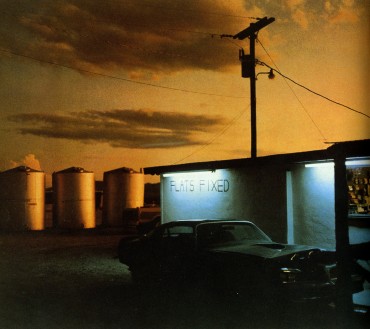Selected Topic
Issue 4 - Cinema – Architecture and Cinema: Real and Fictional Spaces (August 2011)
Show articles
Prof. Dr. Josep Lluís Mateo.

Alfred Hitchcock. North by Northwest, 1959.

Wim Wenders. Terlingua, Texas. Written in the West, Ed. Schirmer/Mosel, 1987.
4.7.2012 – Issue 4 - Cinema – Mateo Josep Lluís – Videos, Studio
ARCHITECTURE and CINEMA
by Josep Lluís Mateo
The relationship between cinema & architecture is mentioned in many occasions and it's partially true. In fact, the architecture in the cinema appears as a background of the scene, as a background of the action. As, happens with photography, the cinema is giving us a specific point of view about things, about the reality and the architecture into it. Into the invention of the plot, the reality (and the architecture inside) appears in a special way, with special light, in a special frame, in a special context.
We all have great memories about films and architecture. My generation for instance has been connected to the Hitchcock representations of modernity or later Wim Wenders surrealistic sensibility about the 50's, David Lynch dreams about landscape and life and many others that continue a certain relationship between the fiction of the film and the reality and the vision about this reality that is the architecture into it.
But I would like to point out the differences in between both. One strong difference is that in fact, the invention of the cinema is based on the movement, on having the images in motion, passing from photographs in a static way to the movement of the images. This kind of motion is clearly the key question of the origin and development of the cinema.
Frankly, and I hope without any kind of reactionary approach, I have to say that architecture is something totally static, something that is more confronted to permanence that really something in motion. In fact, many ideas connected to think, to propose and to built in some occasions architectural pieces following the idea of movement become dramatically like frozen corpses. The idea of movement and the idea of architecture, in my opinion are by definition totally different.
The other clear difference between both disciplines is connected with the spaces where the cinema is projected. The cinema halls are turning more and more in our contemporary times towards a degree zero of architecture, with no light, with no expression. They are only a place where the fiction takes place, with adequate acoustic and climatic conditions but without any architectural character. It's totally different from the old times, from the theatres and operas, where the whole space was confronted to a certain representation of life. The cinema space as a degree zero of architecture is marking a limit where architecture doesn't exist any more, becoming purely an immaterial fact, of course full of interest in a certain way and full of impossibilities in many other ways.
Our research work during the last semester was connected to this kind of confrontation between possibilities and impossibilities. We were using the cinema as a metaphor, as a kind of reference point to research and to develop projects.
--
Images credits (video)
- Alfred Hitchcock. North by Northwest, 1959.
- Wim Wenders. Terlingua, Texas. Written in the West, Ed. Schirmer/Mosel, 1987.
Download article as PDF

